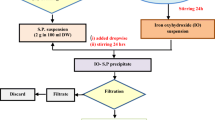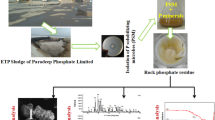Abstract
A large number of rare earth element mining and application resulted in a series of problems of soil and water pollution. Environmental remediation of these REE-contaminated sites has become a top priority. This paper explores the use of Bacillus licheniformis to adsorb lanthanum and subsequent mineralization process in contaminated water. The maximum adsorption capacity of lanthanum on bacteria was 113.98 mg/g (dry weight) biomass. X-ray diffraction (XRD) and transmission electron microscopy (TEM) data indicated that adsorbed lanthanum on bacterial cell surface occurred in an amorphous form at the initial stage. Scanning electron microscopy with X-ray energy-dispersive spectroscopy (SEM/EDS) results indicated that lanthanum adsorption was correlated with phosphate. The amorphous material was converted into scorpion-like monazite (LaPO4 nanoparticles) in a month. The above results provide a method of using bacterial surface as adsorption and nucleation sites to treat REE-contaminated water.




Similar content being viewed by others
References
Agrawal YK, Thomaskutty PT (1987) Separation and determination of microgram amounts of lanthanum(iii) using N-phenylbenzohydroxamic acid and xylenol orange. Analyst 112:1015–1017
Bishop ME, Glasser P, Dong HL, Arey B, Kovarik L (2014) Reduction and immobilization of hexavalent chromium by microbially reduced Fe-bearing clay minerals. Geochim Cosmochim Ac 133:186–203
Bonificio WD, Clarke DR (2016) Rare-earth separation using bacteria. Environ Sci Tech Let 3:180–184
Cheng YJ, Xu XY, Yan SG, Pan XH, Chen Z, Lin Z (2014) Hydrothermal growth of large-size UO2 nanoparticles mediated by biomass and environmental implications. RSC Adv 4:62476–62482
Cheng YJ, Xu XY, Lin WT, Han R, Liu MH (2016) Transformation from organo-Cr (III) to trivalent chromium mineral (guyanaite/grimaldiite) and its environmental implication. Geomicrobiol J 33:948–953
Dash HR, Das S (2016) Diversity, community structure, and bioremediation potential of mercury-resistant marine bacteria of estuarine and coastal environments of Odisha, India. Environ Sci Pollut R 23:6960–6971
Elder RT (1983): Molecular cloning—a laboratory manual Maniatis T, Pritsch Er, Sambrook J. Bioscience 33, 721–722
Fray DJ (2000) Chemical engineering—separating rare earth elements. Science 289:2295–2296
Grawunder A, Merten D, Buchel G (2014) Origin of middle rare earth element enrichment in acid mine drainage-impacted areas. Environ Sci Pollut R 21:6812–6823
Gurumurthy GP, Balakrishna K, Tripti M, Audry S, Riotte J, Braun JJ, Shankar HNU (2014) Geochemical behaviour of dissolved trace elements in a monsoon-dominated tropical river basin, Southwestern India. Environ Sci Pollut R 21:5098–5120
Hou YK, Wu PX, Zhu NW (2014) The protective effect of clay minerals against damage to adsorbed DNA induced by cadmium and mercury. Chemosphere 95:206–212
Huang XY (2015) Preparation and luminescence characteristics of monazite Eu3+:LaPO4 nanocrystals in NH4NO3 molten salt. Opt Mater 50:81–86
Huittinen N, Arinicheva Y, Schmidt M, Neumeier S, Stumpf T (2016) Using Eu3+ as an atomic probe to investigate the local environment in LaPO4-GdPO4 monazite end-members. J Colloid Interf Sci 483:139–145
Kulaksiz S, Bau M (2011) Rare earth elements in the Rhine river, Germany: first case of anthropogenic lanthanum as a dissolved microcontaminant in the hydrosphere. Environ Int 37:973–979
Kulaksiz S, Bau M (2013) Anthropogenic dissolved and colloid/nanoparticle-bound samarium, lanthanum and gadolinium in the Rhine river and the impending destruction of the natural rare earth element distribution in rivers. Earth Planet Sc Lett 362:43–50
Lin WT, Huang Z, Li XZ, Liu MH, Cheng YJ (2016) Bio-remediation of acephate-Pb(II) compound contaminants by Bacillus subtilis FZUL-33. J Environ Sci-China 45:94–99
Marciniak L, Stefanski M, Tomala R, Hreniak D, Strek W (2015) Synthesis and spectroscopic properties of RbLa1-xEuxP4O12 nanocrystals. J Alloy Compd 624:210–215
Markova Z, Siskova K, Filip J, Safarova K, Prucek R, Panacek A, Kolar M, Zboril R (2012) Chitosan-based synthesis of magnetically-driven nanocomposites with biogenic magnetite core, controlled silver size, and high antimicrobial activity. Green Chem 14:2550–2558
Martinez RE, Pourret O, Takahashi Y (2014) Modeling of rare earth element sorption to the gram positive Bacillus subtilis bacteria surface. J Colloid Interf Sci 413:106–111
Pan XH, Chen Z, Chen FB, Cheng YJ, Lin Z, Guan X (2015) The mechanism of uranium transformation from U(VI) into nano-uramphite by two indigenous Bacillus thuringiensis strains. J Hazard Mater 297:313–319
Service RF (2010) Rare-earth elements Chinese policies could pinch US efforts to make electric vehicles. Science 329:377–377
Singh R, Dong HL, Liu D, Zhao LD, Marts AR, Farquhar E, Tierney DL, Almquist CB, Briggs BR (2015) Reduction of hexavalent chromium by the thermophilic methanogen Methanothermobacter thermautotrophicus. Geochim Cosmochim Ac 148:442–456
Stone R (2009) Materials science as China's rare earth R&D becomes ever more rarefied, others tremble. Science 325:1336–1337
Takahashi Y, Hirata T, Shimizu H, Ozaki T, Fortin D (2007) A rare earth element signature of bacteria in natural waters? Chem Geol 244:569–583
Takahashi Y, Chatellier X, Hattori KH, Kato K, Fortin D (2011) Adsorption of rare earth elements onto bacterial cell walls and its implication for REE sorption onto natural microbial mats (vol 219, pg 53, 2005). Chem Geol 288:178–180
Tennesen M (2014) Rare earth. Science 346:692–695
Tsuruta T (2006) Selective accumulation of light or heavy rare earth elements using gram-positive bacteria. Colloid Surface B 52:117–122
Uda T, Jacob KT, Hirasawa M (2000) Technique for enhanced rare earth separation. Science 289:2326–2329
Zhou L, Mavrogenes J, Spandler C, Li HP (2016) A synthetic fluid inclusion study of the solubility of monazite-(La) and xenotime-(Y) in H2O-Na-K-Cl-F-CO2 fluids at 800 degrees C and 0.5 GPa. Chem Geol 442:121–129
Acknowledgements
The authors are grateful to Drs. John Morton, Matthew Duley, and Richard Edelmann for giving us the possibility to perform XRD, TEM, and SEM analyses at Cincinnati University and Miami University. This work was financially supported by the National Basic Research Program of China (973 Program) (no. 2014CB846003) and the National Natural Science Foundation of China (no. 41372346, 21477129). Additional support was provided by the China Scholarship Council (no. 201506655045).
Author information
Authors and Affiliations
Corresponding authors
Additional information
Responsible editor: Guilherme L. Dotto
Yangjian Cheng, Li Zhang equation contribution.
Rights and permissions
About this article
Cite this article
Cheng, Y., Zhang, L., Bian, X. et al. Adsorption and mineralization of REE—lanthanum onto bacterial cell surface. Environ Sci Pollut Res 25, 22334–22339 (2018). https://doi.org/10.1007/s11356-017-9691-0
Received:
Accepted:
Published:
Issue Date:
DOI: https://doi.org/10.1007/s11356-017-9691-0




